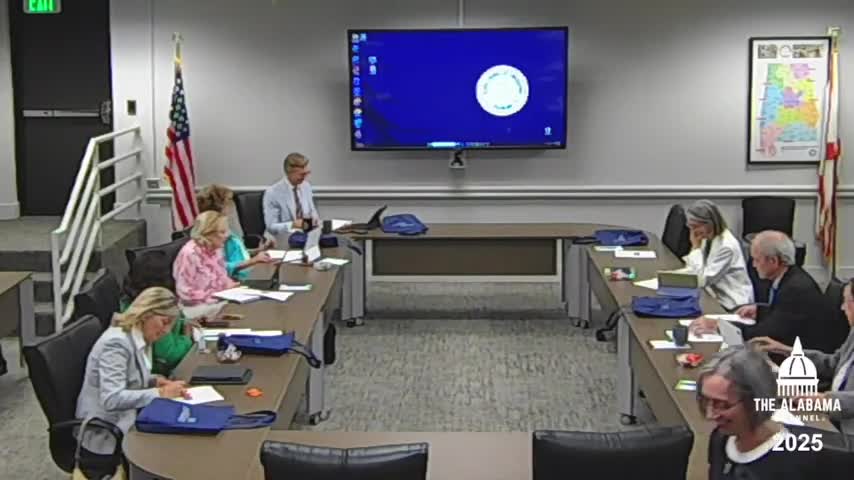Board briefed on proposed Alabama Administrative Code changes to reflect RAISE Act and foundation program updates
October 17, 2025 | Alabama State Department of Education, State Agencies, Executive, Alabama
This article was created by AI summarizing key points discussed. AI makes mistakes, so for full details and context, please refer to the video of the full meeting. Please report any errors so we can fix them. Report an error »

Department staff presented a proposed administrative-code package to align the Alabama Administrative Code with recent legislative changes to the foundation program and to add a new section implementing the RAISE Act distribution rules.
The presenter told board members that most code updates are clerical (fiscal-year references) but that the legislature changed language about how teacher classroom instructional supply funds may be spent. Read verbatim, the proposed code language states: "Funds for classroom material supplies shall not be used to maintain, repair, or replace technology equipment or devices or instructional material that's mandated by the State Department of Education or used in the classroom to provide instruction for students." The department said the code must mirror statutory language.
Staff explained the new RAISE Act section will establish how the additional state money outside the foundation program is distributed this year and budgeted for next year. The presentation said the RAISE Act is formula-driven and allocated entirely to K–12. The department provided a spreadsheet showing the percentage distribution among eligible categories and said the initial RAISE allocation was roughly $166,000,000 in year one.
Gifted funding under the RAISE Act will be calculated using an assumed 5% gifted population and a 4.5 weight. The presenter explained the law assumes 5% of students are gifted and that local education agencies (LEAs) are funded on that assumption; a district with 12% identified gifted students would still be funded for 5% under the statutory formula. The legislature included a one-year hold-harmless provision so districts would not see reductions in the initial year.
Staff also described a charter school component and noted the department would calculate allocations based on fall attendance for charter students. The department described a departmental waiver requirement for local boards that request to move more than 10% of a category’s allocation to other uses; staff said the law itself imposed no cap but the department proposed a 10% notification/waiver threshold to ensure oversight.
Board members asked for clarification on how gifted identification works, whether small rural districts would be disadvantaged under the assumed 5% model and how special education tiers are handled. The presenter said special education allocations are calculated from child counts for specific federal categories and that the RAISE Act identifies tiers for special education funding that the department will apply using actual student counts.
No formal adoption vote on the administrative-code changes was recorded in the supplied transcript excerpt; the department asked for questions and said the proposed code language would be brought back for formal action in the board process.
The presenter told board members that most code updates are clerical (fiscal-year references) but that the legislature changed language about how teacher classroom instructional supply funds may be spent. Read verbatim, the proposed code language states: "Funds for classroom material supplies shall not be used to maintain, repair, or replace technology equipment or devices or instructional material that's mandated by the State Department of Education or used in the classroom to provide instruction for students." The department said the code must mirror statutory language.
Staff explained the new RAISE Act section will establish how the additional state money outside the foundation program is distributed this year and budgeted for next year. The presentation said the RAISE Act is formula-driven and allocated entirely to K–12. The department provided a spreadsheet showing the percentage distribution among eligible categories and said the initial RAISE allocation was roughly $166,000,000 in year one.
Gifted funding under the RAISE Act will be calculated using an assumed 5% gifted population and a 4.5 weight. The presenter explained the law assumes 5% of students are gifted and that local education agencies (LEAs) are funded on that assumption; a district with 12% identified gifted students would still be funded for 5% under the statutory formula. The legislature included a one-year hold-harmless provision so districts would not see reductions in the initial year.
Staff also described a charter school component and noted the department would calculate allocations based on fall attendance for charter students. The department described a departmental waiver requirement for local boards that request to move more than 10% of a category’s allocation to other uses; staff said the law itself imposed no cap but the department proposed a 10% notification/waiver threshold to ensure oversight.
Board members asked for clarification on how gifted identification works, whether small rural districts would be disadvantaged under the assumed 5% model and how special education tiers are handled. The presenter said special education allocations are calculated from child counts for specific federal categories and that the RAISE Act identifies tiers for special education funding that the department will apply using actual student counts.
No formal adoption vote on the administrative-code changes was recorded in the supplied transcript excerpt; the department asked for questions and said the proposed code language would be brought back for formal action in the board process.
View full meeting
This article is based on a recent meeting—watch the full video and explore the complete transcript for deeper insights into the discussion.
View full meeting
